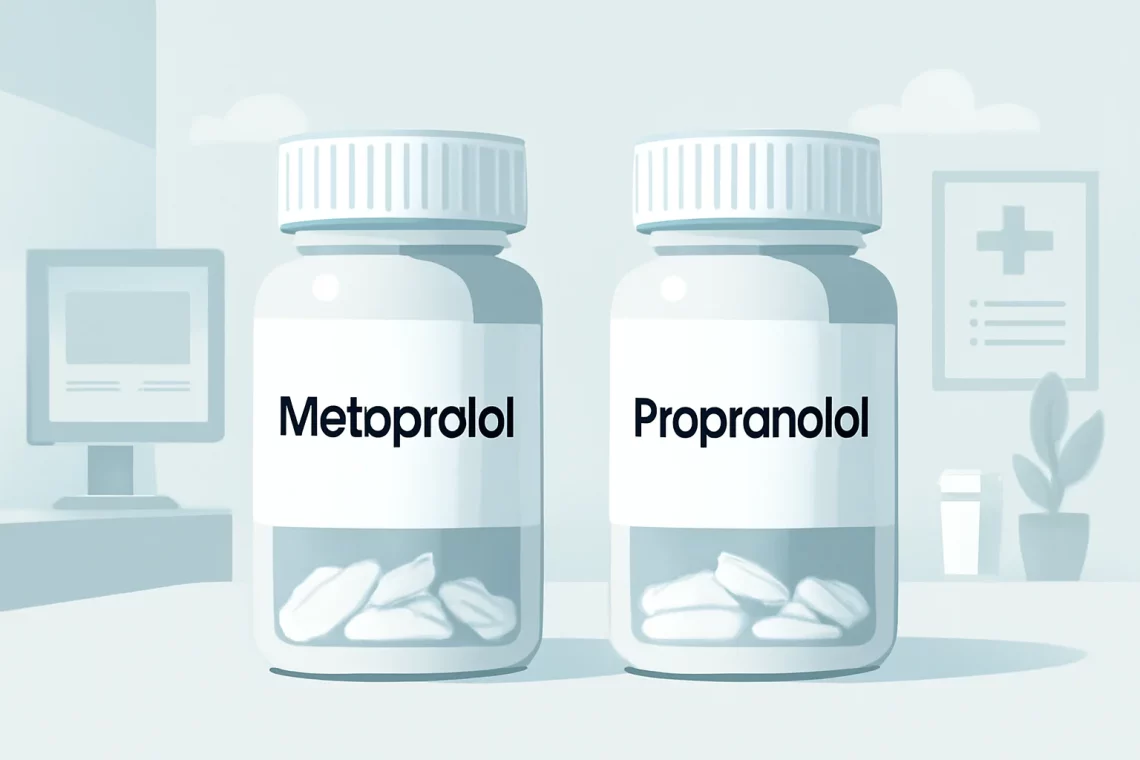
Metoprolol vs Propranolol: Key Differences and Uses Explained
Metoprolol and propranolol are two widely prescribed medications belonging to the class of drugs known as beta-blockers. These medications are primarily used to manage various cardiovascular conditions, such as hypertension, angina, and arrhythmias. However, their mechanisms of action, therapeutic applications, and side effect profiles differ significantly, making them suitable for different patient needs. Understanding these differences is crucial for both healthcare professionals and patients, as it can influence treatment efficacy and safety.
Beta-blockers work by blocking the effects of adrenaline on beta-adrenergic receptors, leading to a decrease in heart rate and blood pressure. This class of drugs is beneficial not only for heart-related issues but also for other conditions such as anxiety and migraine prevention. Metoprolol is a selective beta-1 blocker, primarily affecting the heart, which can be advantageous for patients with specific cardiovascular concerns. Conversely, propranolol is a non-selective beta-blocker that impacts both beta-1 and beta-2 receptors, making it effective for a broader range of conditions but potentially leading to more side effects.
In the following sections, we will delve deeper into the characteristics, uses, and differences of metoprolol and propranolol, providing a comprehensive overview for those considering these treatments.
Understanding Metoprolol
Metoprolol is a selective beta-1 adrenergic receptor blocker, which means it primarily targets the receptors found in the heart. This selectivity makes it an ideal choice for patients who require blood pressure management without significantly affecting other systems, such as the lungs.
One of the primary indications for metoprolol is the treatment of hypertension. By reducing heart rate and contractility, metoprolol helps lower blood pressure and decrease the workload on the heart. This can be particularly beneficial for individuals with a history of heart disease or those who are at risk for developing heart-related conditions.
In addition to hypertension, metoprolol is often prescribed for the management of angina, a condition characterized by chest pain due to reduced blood flow to the heart. By improving blood flow and oxygen delivery during physical exertion, metoprolol can help alleviate the symptoms of angina, allowing patients to engage in daily activities more comfortably.
Another significant use of metoprolol is in the treatment of heart rhythm disorders, such as atrial fibrillation. By slowing down the heart rate and stabilizing electrical conduction pathways, metoprolol can help restore a normal rhythm and reduce the risk of complications associated with arrhythmias.
Metoprolol is generally well-tolerated, but like any medication, it can have side effects. Common side effects include fatigue, dizziness, and gastrointestinal disturbances. In some cases, patients may also experience sleep disturbances or depression. It is important for patients to discuss any potential side effects with their healthcare provider to ensure the benefits of the medication outweigh the risks.
Understanding Propranolol
Propranolol, on the other hand, is a non-selective beta-blocker, meaning it affects both beta-1 and beta-2 adrenergic receptors. This broader action allows propranolol to be effective in treating a variety of conditions beyond cardiovascular issues.
One of the most common uses of propranolol is in the management of hypertension, similar to metoprolol. By blocking the effects of adrenaline, propranolol reduces heart rate, the force of heart contractions, and overall cardiac output, which helps lower blood pressure.
Propranolol is also widely used for the treatment of anxiety disorders, particularly performance anxiety or stage fright. By dampening the physical symptoms of anxiety, such as increased heart rate and tremors, propranolol allows individuals to perform better in stressful situations.
In addition to anxiety, propranolol is effective in preventing migraines. Studies have shown that regular use of propranolol can significantly reduce the frequency and severity of migraine attacks, making it a popular choice for patients suffering from chronic migraines.
While propranolol is beneficial for many conditions, its non-selective nature means it can also lead to side effects that are less common with selective beta-blockers like metoprolol. Some patients may experience bronchoconstriction, which can be problematic for individuals with asthma or chronic obstructive pulmonary disease (COPD). Other potential side effects include fatigue, dizziness, and gastrointestinal issues, similar to those associated with metoprolol.
Patients considering propranolol should have a thorough discussion with their healthcare provider regarding their medical history and any pre-existing conditions to ensure the medication is appropriate for their needs.
Comparative Analysis: Metoprolol vs. Propranolol
When comparing metoprolol and propranolol, several key differences emerge that can impact a patient’s treatment plan. The selectivity of these medications plays a significant role in their therapeutic applications and side effect profiles.
Metoprolol’s selective action on beta-1 receptors makes it a safer option for patients with respiratory issues, as it is less likely to cause bronchoconstriction. This selectivity is particularly important for individuals with asthma or other chronic lung conditions, where a non-selective beta-blocker like propranolol could exacerbate symptoms.
In terms of efficacy, both drugs are effective for managing hypertension and heart-related issues. However, the choice between the two often depends on the patient’s overall health, concurrent conditions, and specific needs. For example, if a patient requires anxiety management or migraine prevention alongside cardiovascular treatment, propranolol may be the preferred option due to its broader range of applications.
The side effect profiles also differ between the two medications. While both can cause fatigue and dizziness, propranolol’s non-selective nature can lead to more pronounced respiratory side effects, which can be a significant consideration for certain patients.
Additionally, the dosing and administration of the two drugs may vary. Metoprolol is available in both immediate-release and extended-release formulations, allowing for more flexible dosing options based on patient needs. Propranolol, while also available in multiple forms, may require more careful monitoring due to its broader effects on the body.
Ultimately, the choice between metoprolol and propranolol should be made in consultation with a healthcare provider, who can assess the individual’s health history, current medications, and specific treatment goals.
Conclusion
In conclusion, both metoprolol and propranolol serve as essential tools in the management of cardiovascular conditions and other health issues. Each medication has its own strengths and weaknesses, making it crucial for patients to understand these differences when discussing treatment options with their healthcare providers.
While metoprolol is a selective beta-1 blocker primarily used for heart-related conditions, propranolol’s non-selective action allows it to address a wider range of issues, including anxiety and migraines. The choice between these two medications should be informed by individual health needs, potential side effects, and the overall treatment strategy.
As with any medication, it is vital for patients to communicate openly with their healthcare providers about their experiences, side effects, and concerns. This collaborative approach will help ensure the safest and most effective use of these medications.
**Disclaimer:** This article is not intended to serve as medical advice. For any health-related issues or concerns, it is essential to consult a qualified healthcare professional.




